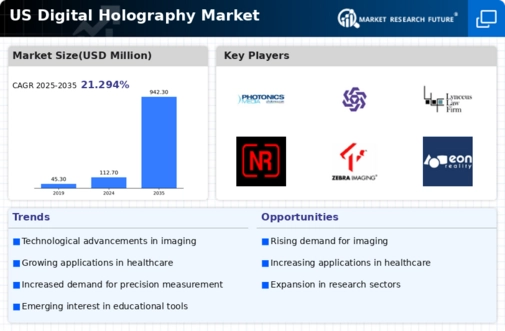Growing Demand for 3D Visualization
The digital holography market is witnessing a growing demand for 3D visualization across various industries. This trend is particularly evident in sectors such as entertainment, education, and architecture, where immersive experiences are becoming increasingly important. The ability to create realistic 3D representations allows for enhanced presentations and improved understanding of complex concepts. Market data indicates that the 3D visualization segment is expected to account for over 40% of the digital holography market by 2026. As industries recognize the value of 3D visualization, the digital holography market is likely to benefit from increased adoption and investment in related technologies.
Expansion of Industrial Applications
The digital holography market is experiencing expansion due to its increasing applications in various industrial sectors. Industries such as manufacturing, automotive, and aerospace are leveraging holography for quality control, inspection, and measurement purposes. The precision offered by holographic techniques allows for real-time monitoring and analysis, which is essential for maintaining high standards in production. Recent market data suggests that the industrial segment is expected to grow at a CAGR of 22% over the next few years. As industries continue to adopt advanced technologies, the digital holography market is likely to see sustained growth driven by these industrial applications.
Technological Advancements in Imaging
The digital holography market is experiencing a surge due to rapid technological advancements in imaging techniques. Innovations in sensor technology and computational algorithms are enhancing the quality and resolution of holographic images. This improvement is particularly relevant in sectors such as healthcare and manufacturing, where precise imaging is crucial. For instance, the integration of artificial intelligence in holography is streamlining data analysis, thereby increasing efficiency. The market is projected to grow at a CAGR of approximately 25% over the next five years, driven by these advancements. As imaging technology continues to evolve, the digital holography market is likely to expand, attracting investments and fostering new applications.
Increased Investment in Research and Development
Investment in research and development is a critical driver for the digital holography market. Companies are allocating substantial resources to explore new applications and improve existing technologies. This focus on R&D is fostering innovation, leading to the development of advanced holographic systems that can be utilized in various fields, including security, telecommunications, and medical imaging. The digital holography market is projected to see a growth rate of around 20% as a result of these investments. Furthermore, collaborations between academic institutions and industry players are likely to accelerate advancements, creating a robust ecosystem for the digital holography market.
Rising Interest in Augmented and Virtual Reality
The digital holography market is benefiting from the rising interest in augmented reality (AR) and virtual reality (VR) technologies. As these technologies gain traction in gaming, training, and simulation, the demand for high-quality holographic displays is increasing. The ability to overlay digital information onto the real world enhances user experiences, making holography an attractive solution for developers. Market analysts suggest that the AR and VR segment could contribute significantly to the digital holography market, potentially accounting for 30% of the total market share by 2027. This growing interest indicates a promising future for the digital holography market.


















Leave a Comment